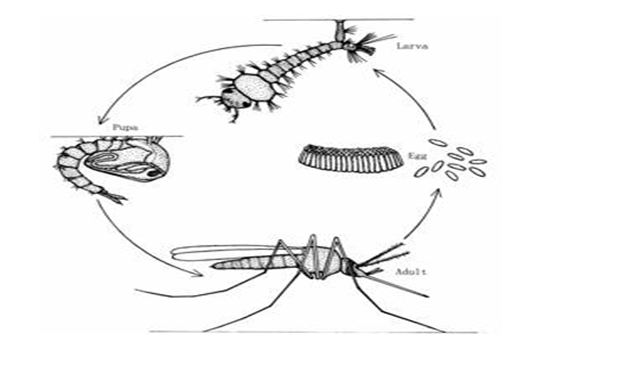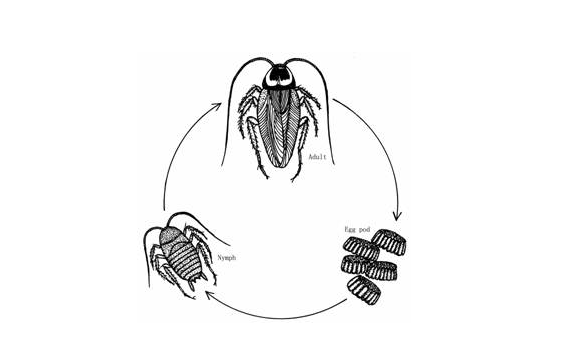Back to: BIOLOGY SS3
Welcome to class!
In today’s class, we will be talking about the development of new organisms (courtship behaviour in animals, stages in the development of toad, insects). Enjoy the class!
Development of New Organisms

CONTENT
- Courtship behaviour in animals
- Stages in the development of toad
- Metamorphosis in insects
- Life histories of housefly and cockroach
Courtship behaviours in animals
Courtship is a reproductive communication between males and females of a species that ends in sexual union. Courtship behaviours in animals include
- Pairing: A form of courtship in which a compatible male and female separate themselves from others in a group to form a mating pair. Pairing occurs in human, toad, fish, winged termites etc.
- Display: A process involving fixed pattern movements or attractive exhibitions and responses between a male and a female which ends in mating. Examples of display include croaking in toads, dancing, singing in human, production of odour by females, stunning tail feathers of a peacock etc.
- Territoriality: A form of behaviour in which a member of a specie marks out a fixed area and defend it against intruders of the same species. Usually, males establish territories before mating. Territories are established by most vertebrates except amphibians.
- Seasonal migration: Seasonal movement of animals from one place to another in connection with breeding, feeding and escaping unfavourable climatic conditions. Termites, birds, fish etc exhibit seasonal migration.
Stages in the development of Toad
In toad, an amphibian and a vertebrate, Courtship takes place during the rainy season when male toads make loud croaking noise to attract females which are swollen with eggs. The male later climbs the female back, holding her firmly with the thick parts on its thumbs. As the female lays her eggs, the male releases its sperms on them (external fertilization). The developmental stages after fertilization include
- The egg stage: the eggs laid are enclosed in strings of jelly which perform the following roles: (i) Protecting the egg from mechanical damage (ii) Ensuring easy access to oxygen for survival (iii) Preventing microbial attack (iv) Preventing the egg from drying up
- The zygote (fertilized egg) stage: After fertilization, the zygote formed undergo mitotic cell division for the embryo to emerge. The embryo gets its food from egg yolk and dissolved oxygen through the jelly.
- The young tadpole stage: The young tadpole emerges from the jelly after 1-2 days. The tadpole attaches itself to a water weed by a sticky substance secreted by its v-shaped cement gland (from under its head) The tadpole feeds on egg yolk (no mouth yet) and gets its dissolved oxygen through the skin. Developing eyes, ears and nostrils are seen with a marked portion for the mouth.
- The external gill stage: The young tadpole has a head, body and tail. Three external gills are found on either side of the head. It develops horny jaws which are used to feed on water weeds. The intestine is long and coiled with the cement gland still present.
- Internal gill stage: 6-10 after hatching, the external gills disintegrate while the internal gills develop. A gill cover called operculum grows over the gills. The tadpole now breathes like a fish. Its tail elongates and muscles develop.
- The limb stage: The hind limbs grow first and develop. The forelimbs then start to grow out. The left forelimb appears first through the opercular opening followed by the right forelimb. The internal gills gradually disintegrate while the lungs start developing. The mouth develops and replaces the horny jaws. Intestine shortens and the tadpole starts eating small animals in the water. The eyes become big and prominent.
- Young toad stage: The tadpole reabsorbs the tail and then changes into a small toad. It comes out of the water to the land where it grows into a full adult toad.
Metamorphosis in a toad (from egg to the adult toad) takes about 40-45 days under the control of the hormone thyroxine produced by the thyroid gland (found between the head and the trunk).
Evaluation
- List the stages in the metamorphosis of a toad.
- Differentiate between external and internal gill stages of toad metamorphosis.
Metamorphosis in insects
Metamorphosis is the gradual changes that occur during the development of an animal from the zygote (fertilized egg) to the adult stage. There are two types of metamorphosis in insects which include
- complete metamorphosis
- incomplete metamorphosis
Complete metamorphosis:
This is the series of gradual changes which takes place in insects from fertilized eggs to larva then to pupa and finally to the adult stage:
Egg ——– larva ——- pupa ——- adult
No resemblance between pupa and adult stage. Insect undergoing complete metamorphosis include housefly, mosquito, butterfly, bees, wasps and beetles.
Incomplete metamorphosis:
In this type of metamorphosis, the egg hatches into a nymph which generally resembles the adult except that it is smaller, wingless and sexually immature.
Egg ——- nymph ——- adult
Evaluation
- What is metamorphosis
- Name the stages involved in complete and incomplete metamorphosis
Life history of a housefly
Housefly undergoes complete metamorphosis. Its life history involves: –
- Egg stage: 2 – 7 batches of eggs (100 – 150 eggs in a batch) are laid by the female housefly in a moist dirty environment. The eggs hatch into white larvae in about 8 – 24 hours.
- Larva stage: The larva called maggot has a segmented body. The head bears a pair of hook for tearing food and drawing the larva along. On the ventral surface of the segmented body lie spiny pads for movement. It has two pairs of spiracles for breathing. The larva moults several times and lasts for about 5 – 14 days after which it moves to a dry place to begin the pupal stage.
- Pupal stage: The maggot shortens; its skin becomes hard and brown forming the pupal case (puparium). It does not feed or move. Internal re-organisation takes place at this stage. In about 3 – 10 days, the young adult hatches out of the puparium.
- Adult stage: The adult housefly called imago emerges from the puparium using a sac-like organ (ptilinum) to break it open. It moves to the surface of the dirt and flies away when the wings are dry.

Life history of a cockroach
Cockroach undergoes incomplete metamorphosis. Its life history involves.

- Egg stage: A female cockroach lays about 10 – 16 eggs in a horny egg case (ootheca) which she carries in her abdominal pouch for some time and later deposit it in a safe dark. After 30 – 100 days, the eggs hatch into nymphs which are wingless, small and whitish in colour.
- Nymph stage: The nymphs feed, grow, become brown, moult about 13 times to become adults.
- Adult stage: In the process of moulting, the wings first appear as wing pad and later into full-grown wings. A cockroach requires 11 – 20 months to develop from eggs to imago.
Evaluation
Describe briefly metamorphosis in a) cockroach b) housefly
General evaluation
- Define metamorphosis
- Describe the stages involved in the development of toad.
- Define complete and incomplete metamorphosis in insects. Give two examples in each case.
- Differentiate between complete and incomplete metamorphosis.
- Describe the life cycle of a named insect that undergoes complete metamorphosis.
Reading assignment
College Biology, Chapter 16, page 354 – 360, 370 – 373
Weekend assignment
- The following insects undergo incomplete metamorphosis except for (a) grasshopper (b) cockroaches (c) butterfly (d) termite
- The young tadpole feeds on ——– (a) small animals (b) waterweed (c) egg yolk (d) fish
- Which of these is not a function of the string of jelly covering on eggs laid by toad (a) nourish the embryo (b) protect eggs from microbial attack (c) protect eggs from mechanical damage( d) protect eggs from drying up
- The larva of a mosquito is called (a) caterpillar (b) grub (c) wriggler (d) imago
- A common process that occurs in the metamorphosis of insects is (a) moulting (b) feeding (c) fertilization (d) dormancy
Theory
- Differentiate between metamorphosis in butterfly and termites
- Differentiate between the external and internal gill stage of toad’s development
In our next class, we will be talking about the Development of New Organisms (Seeds, Fruits in Plants, Germination of Seeds). We hope you enjoyed the class.
Should you have any further question, feel free to ask in the comment section below and trust us to respond as soon as possible.
